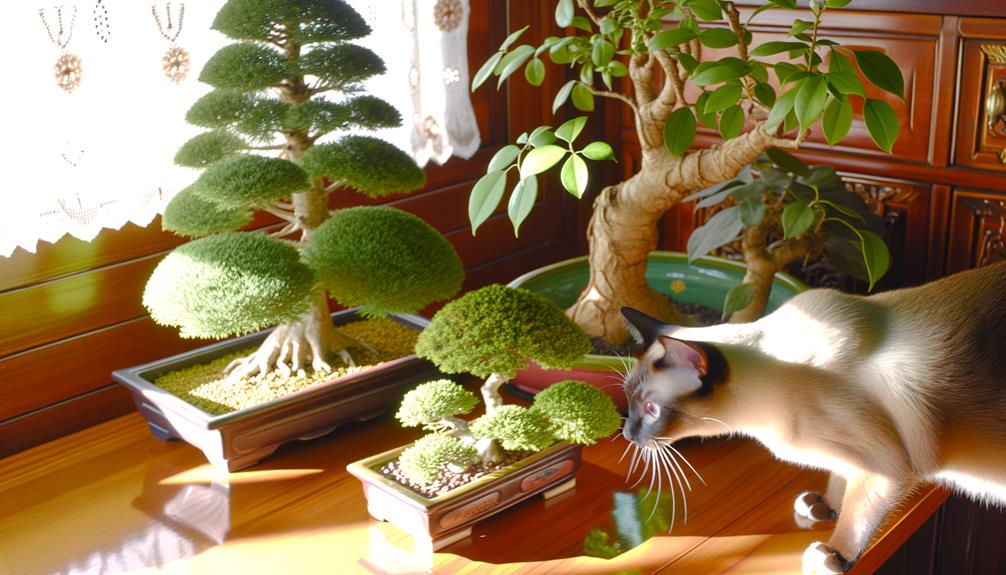How to Keep Cats Safe Around Bonsai Trees
Many bonsai trees can be toxic to cats, with species like azaleas, sago palms, and jade plants posing particular risks. Ingestion can lead to symptoms such as vomiting, diarrhea, and severe organ failure.
However, non-toxic options like the Japanese Maple, Bamboo Palm, Dwarf Olive Tree, and Money Tree are safe choices. Always consult with a veterinarian to confirm plant safety.
For best pet safety, place bonsai trees out of reach and monitor for signs of interference. Understanding the details of cat-friendly bonsai options and preventive measures is essential.
Continue exploring to discover how to create a safe environment for pets and plants alike.

Key Takeaways
- Japanese Maple and Bamboo Palm bonsai trees are safe options for households with cats.
- Certain bonsai species like azaleas, sago palms, and jade plants are toxic to cats.
- Symptoms of plant poisoning in cats include vomiting, diarrhea, drooling, and lethargy.
- Consulting with a veterinarian ensures the safety of bonsai choices for cats.
- Placing bonsai trees out of cats' reach helps prevent accidental ingestion and poisoning.
Common Bonsai Plant Types

Among the most favored bonsai plant types for feline-friendly households are the Ficus, Jade, and Japanese Maple species.
The Ficus, known for its robust trunk and glossy leaves, is a popular choice due to its resilience and minimal maintenance needs.
Jade plants, with their thick, succulent leaves, offer an aesthetically pleasing, low-maintenance option that thrives in indoor environments.
Japanese Maple, with its delicate, lace-like foliage, provides an elegant touch and can adapt well to various light conditions.
Each of these bonsai species presents unique visual appeal and practical benefits, making them suitable for homes with cats.
Their adaptability and ease of care contribute to their popularity among bonsai enthusiasts and pet owners alike.
Toxicity Concerns for Cats
While selecting the ideal bonsai tree for a home with cats, it is essential to contemplate the potential toxicity of certain plants to guarantee the safety of your feline companions. Many bonsai species, including popular choices like azaleas, sago palms, and jade plants, can be harmful if ingested by cats. These plants contain toxins that may cause symptoms ranging from mild gastrointestinal upset to severe organ failure.
It is vital to thoroughly research the specific bonsai species before introducing them into a home with pets. Opting for non-toxic varieties such as the Japanese maple or the parlor palm can mitigate these risks. Consulting with a veterinarian or a plant specialist can further ensure the well-being of your pets.
Signs of Plant Poisoning

Recognizing the signs of plant poisoning in cats is important for prompt and effective treatment. Cats may exhibit a range of symptoms depending on the type and amount of plant ingested. Common indicators include vomiting, diarrhea, drooling, and loss of appetite. Neurological signs such as tremors, seizures, and unsteady gait may also occur.
Some cats may show signs of lethargy, excessive thirst, or difficulty breathing. Behavioral changes, like increased irritability or hiding, can also be indicative of plant toxicity. If you observe any of these symptoms, immediate veterinary consultation is vital.
Early detection and intervention can greatly improve outcomes and prevent severe complications. Always monitor your cat's behavior closely to guarantee their safety around potentially toxic plants.
Cat-Friendly Bonsai Options
Securing the safety of your feline companions, several bonsai tree species are non-toxic and suitable for households with cats. Among the cat-friendly options, the Japanese Maple (Acer palmatum) stands out for its non-toxic nature and aesthetic appeal.
Similarly, the Bamboo Palm (Chamaedorea) is a safe and attractive choice that poses no risk to felines. Another excellent option is the Dwarf Olive Tree (Olea europaea), which is both non-toxic and easy to maintain.
The money tree (Pachira aquatica) is also a popular, safe choice. These species not only enhance the visual charm of your home but also provide a safe environment for your pets. Selecting these specific bonsai trees can help cat owners cultivate a harmonious living space.
Tips for Safe Coexistence

Creating a safe living space for both your bonsai trees and your cats involves a few strategic practices to guarantee harmony and well-being. Begin by selecting non-toxic bonsai species like the Chinese Elm or Japanese Maple. Place bonsai trees on high shelves or enclosed displays to deter curious cats. Regularly inspect your bonsai for signs of cat interference and correct any damage promptly. Providing alternative cat-friendly plants and designated play areas can reduce your cat's interest in your bonsai. Ensure proper hydration and care for your bonsai to maintain their health and resilience.
| Practice | Benefit |
|---|---|
| Select non-toxic species | Prevents poisoning |
| Use high shelves or enclosures | Keeps bonsai out of reach |
| Regular inspections | Identifies and corrects damage |
Conclusion
In the delicate dance between nature's miniature art and feline companions, understanding the toxicity of various bonsai plants becomes crucial.
Recognizing the signs of plant poisoning and selecting cat-friendly bonsai options can guarantee harmony in the household.
By implementing appropriate safety measures, one mirrors the careful pruning of a bonsai tree, fostering an environment where both flora and fauna can flourish.
Therefore, the serene balance of a well-tended bonsai garden can coexist with the presence of curious cats.






